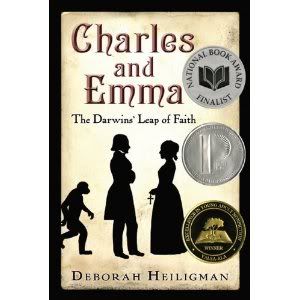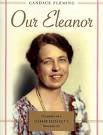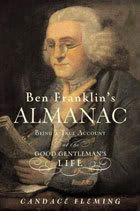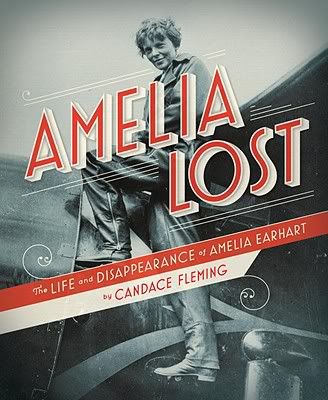Monday, August 8, 2011
Amelia Lost by Candace Fleming
I previously read and reviewed Candace Fleming’s biographies of Benjamin Franklin and Eleanor Roosevelt. So when I saw that she recently released a biography of Amelia Earhart I was thrilled. I ordered it in at the library and thoroughly enjoyed Fleming’s talent for making history entertaining. The opening chapter starts with the dramatic story of Amelia Earhart’s last but fateful flight. The scene portrays the instant when the navy crews expecting Amelia’s arrival first realized she was lost.
The book then switches to information about Amelia’s childhood, and those experiences that gave her the personality and interest for being an aviatrix. So, the biography continues to switch between the narrative history of Amelia’s life and the dramatic clips about what happened after the Navy discovered that Amelia was lost.
I found this biography fascinating, as this time period is full of so much adventure. The author manages to convey just how dangerous the beginning of aviation was, and the progress that it made through Amelia’s life. I felt that the biography showed just how courageous Amelia was but illustrated that her courage also made her reckless in her decision making. To every virtue there is the downfall. The biography also discussed how strongly Amelia felt about women being able to do the same as men, and portrayed this as a motivating factor behind her flying. As a result Amelia Earhart inspired a generation of woman. I found this honest and human look at this legendary woman to be inspiring and interesting.
I really love Candace Fleming. I hope she writes more books similar to this one, though they must take years of work.
Visit the website of Candace Fleming
Friday, April 23, 2010
Charles and Emma: The Darwins' Leap of Faith

Charles and Emma: The Darwins’ Leap of Faith by Deborah Heiligman
“In the summer of 1838, in his rented rooms on Great Marlborough street, London, Charles Darwin drew a line down the middle of a piece of scrap paper. He had been back in England for almost tow years, after a monumental voyage around the world. He was in his late twenties. It was time to decide. Across the top of the left-hand side he wrote Marry on the right he wrote Not Marry. And in the middle: This is the Question.”
(Charles and Emma, p 5)
Thus opens Deborah Heiligman award winning book about Charles and Emma Darwin. How can you not want to read on after reading an opening like that? This humorous little scrap of paper still exists! Who knew that a boring scientist could be so hilarious and intriguing?
I have to stay that I absolutely adored this book, but first off I should make clear that it is a biography, and not a historical fiction novel. The biography specifically focuses on Charles Darwin and his wife (and cousin) Emma Wedgewood, and they life that they built together. They really did love one another and lived a happy life, but their views differed greatly on the topic of religion.
I think the author did well at representing how Darwin was a moral man, and even at one point a man of faith, but how he slowly changed his views of religion and God. He was a man, who thought seriously about the world, and his science, and how his theories would affect the scientific community at large. It also portrayed how hard it was for his wife Emma to know that he did not have a stronger faith.
I like how the author shows how Darwin’s contemporaries—family, friends, and other scientists—reacted to his theories. In particular, I like how she included Darwin’s correspondence with Asa Gray, who was a strong supporter of the evolution theory, and maintained that it did not necessarily have to take God out of creation. It was nice to know about those who objected to the theory on a religious basis, and those that agreed to the theory as atheist or agnostics, and those, similar to Asa Gray, that took a route in the middle. As a result, I as a reader felt that book encouraged a more opened-minded dialogue about how religion and science relate to one another. The author’s tone played fair to religion and science alike.
While I really liked how the author treated the eternal religion v.s. science debate I think my enjoyment of the biography was increased by the fact that I love this time period, and that I really do love studying nature and understanding how it works on a macroscopic level. I loved hearing about how Charles Darwin would compare how his children’s expressions of excitement to how animals expressed excitement. It was hilarious to read one of Emma’s letters about how he was trying to train worms with huge leafs of lettuce.
Overall, I really enjoyed this biography and would recommend it to all. I feel readers of many different opinions on the subject could read it and come away enlightened about the topic of evolution. In fact the book points out some of the misinterpretations and misunderstandings that surround the theory. There are a few pages that deal with Charles Darwin’s analysis of animal mating practices and how that was similar to how humans react to one another in a romantic way that could be slightly offensive to parents who have younger readers. So, while the book is for the most part family friendly, the book really is geared towards teens and older.
Author's Website
Monday, December 22, 2008
Our Eleanor by Candace Flemming

Earlier this year I read a “scrapbook” biography of Benjamin Franklin’s life written by the same author. This Biography is about Eleanor Roosevelt, and her tremendous life. I’m so glad I came across this book, and read it. It gave me a whole new picture of this revolutionary woman. I always knew that Eleanor was a unique figure in history, but this really made me understand her life and the influence she held in America at the time. I hadn’t known that she was the first woman delegate to the United Nations, or that she helped to write the Universal Declaration of Human Rights, or that she was a huge leader in the Democratic party for many years.
The number of things that she accomplished in life is absolutely amazing, and it was for the majority centered around helping people in all walks of life, and in dozens of different places. Yet this biography also shows the human side of her, how her marriage wasn’t picture perfect, and her mother-in-law was controlling and overbearing. My favorite detail was the fact that she was a terrible driver. She got in car accidents all the time, complete with newspaper articles detailing what happened. This entertaining and informative biography really is a delight to read.
I really do love how this format allows the reader to view primary documents along with the narrative text, though I wished that some of the scanned documents had been larger and clearer, because I was squinting to read them. The book is full of pictures, documents, cartoons, articles, letters, and posters that make the book more fascinating. This was a really excellent book, and an excellent resource for young people interested in history. I would highly recommend this to all!
Author's Website:http://www.candacefleming.com/
Monday, July 21, 2008
Ben Franklin's Almanac by Candace Fleming

“
But as I read Ben’s letters and essays, looked at pictures of his family, and uncovered Franklin stories and anecdotes, I began to see him differently. Innovative, vulgar, sometimes heroic, sometimes flawed, the incredibly complex Ban Franklin I discovered beguiled me, and I was no longer satisfied to tell his story in a ordinary way. I needed a form that would illuminate each of the many facets of his life—the vastness of his interests and accomplishments, and the deep commitment he made to each one….And like a scrapbook, the stories of Ben’s life has been centered around visuals—portraits, etchings, cartoons, and sketches. These images—most created long ago—will bring you face-to-face with history, and help you to connect with Ben the person, rather than just a name and dates. You will actually see Ben’s childhood home. You will see his electrical equipment, the faces of his family, the first pages of his most famous writings. And hopefully, like the individual pieces of a jigsaw puzzle, these snapshots will come together and a whole picture of Ben Franklin will emerge.” ~Candace FlemingThis middle grade non-fiction biography of Ben Franklin’s life includes multiple, cartoons, pictures, images that come directly from Franklin’s own life. The Biography is not organized in a chronological form, but by chapter theme. Some chapter topics are: “Boyhood Memories,” “A Family Album,” “Tokens of Well-Lived life,” and “Revolutionary Memorabilia.” This book totals 120 pages, and includes a Year-by-Year look at Ben’s life, a bibliography, picture sources, and recommendations for books and websites about Ben for Younger readers.
The instant I opened this book I absolutely adored it! I seriously love this book! Each of the pages is typeset to looks exactly like a pamphlet, broadside, newspaper or almanac from the colonial era, except the print is far more legible. Most of the images or pictures are from the time-period, something the Ben would have printed, or seen himself during his lifetime. They are all black and white, and add to the illusion that you are reading from an old book. The book has fun little anecdotes and stories about Ben’s life, and illustrates his humor, wit, and intelligence. I wonder if the book should be for middle grade readers, since Franklin’s prose is a product of his time and a bit hard to understand at times. Still each page has a layout that looks like old newspaper articles, complemented with pictures. These little articles are small and approachable to read, and I can see myself as a small student browsing through and reading the small articles and looking at the pictures. Then as I became an older student going through and reading some of the longer passages and learning the more complex background behind Franklin’s life and inventions. This truly is an innovative and versatile scrapbook of Ben’s life that will bring entertainment to readers of all ages. The history major in me applauds.
This book is a James Madison Honor Book, and had won multiple other awards. The author has published several other scrapbook looks into the life of American Heroes and also writes fiction. Check out her other work at her website: http://www.candacefleming.com/index.html
Monday, June 23, 2008
Book Review: Ravens in the Winter by Bernd Heinrich

No one can say I did not expand my reading horizons this summer because I just finished reading a 379 page scientific study on Ravens. Bern Heinrich is a professor of zoology and decided to answer the question of why Ravens feed together when the find a dead carcass to scavenge. The book and its discoveries give a lot of insight to Raven society and sociality. I found the study really interesting, though sometimes the essays and experiment notes got way repetitive. It seemed just when I was going to put the book down he moved onto another essay topic like Raven intelligence, or the pet Ravens he kept at home, Raven’s nesting habits, or trapping Ravens in a cage, or building a Raven study site. I really had a lot of fun learning so much about Ravens and their habits.
So, yeah, unless you are a die-hard animal/bird lover then you probably won’t make it through this book very easily. There is a reason my husband is fond of calling me “bird brain,” and it’s not cause I’m stupid. It is because I’m crazy about birds. Especially black birds, and since a Raven is currently the main character of one of my novels I decided to do some research, and I’m really glad I did because there are going to have to be some major changes in my Raven’s behavior!
Anyway, this guy, at the time of his writing the book, was only the third person in the world who had captured Ravens and tagged them for study. They are really interesting but extremely shy birds, and so it is incredibly hard to study them at all. I like how this book didn’t show that Raven’s had some kind of mythical intelligence, because that is what the typical Raven book is about, but instead discussed that they had a complex social hierarchy, and interesting habits. This was a fun, but difficult read, yet ultimately rewarding.

